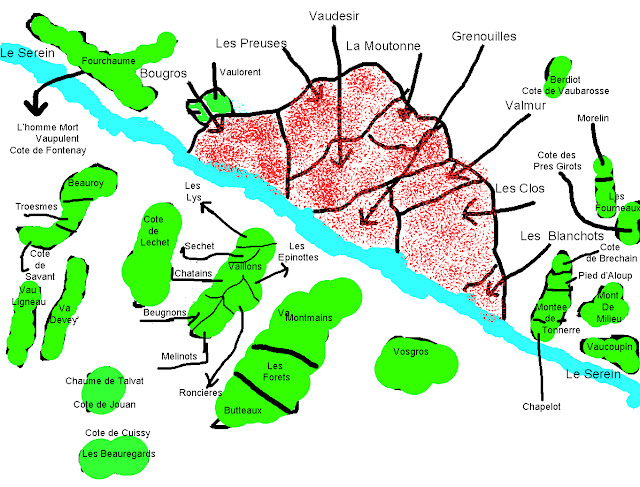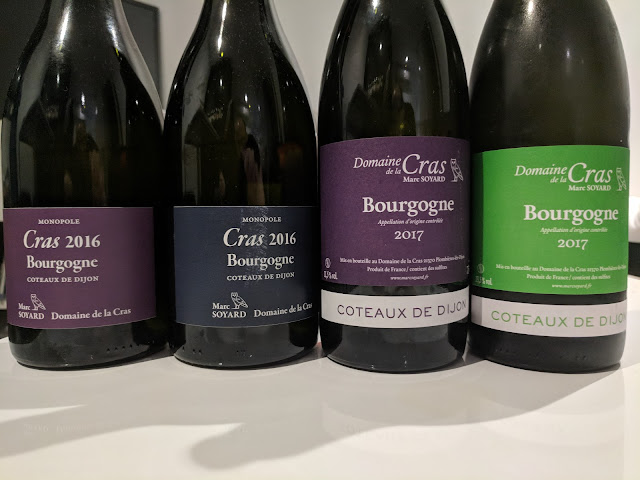Poulsard (also Ploussard) is a red French wine grape variety from the Jura wine region. The name Ploussard is used mainly around the town of Pupillin but can appear on wine labels throughout Jura as an authorized synonyms. While technically a dark-skinned noir grape, the skins of Poulsard are very thin with low amounts of color -phenols and produces very pale colored red wines, even with extended maceration and can be used to produce white wines. Because of this, Poulsard is often blended with other red-skin varieties or used to produce lightly colored rosé wines. Additionally the grape is used to make blanc de noir white wines and sparkling cremants.[1][2]
Poulsard is an authorized grape variety in the Appellation d'Origine Contrôlée (AOC) wines of Arbois AOC, Côtes du Jura AOC, Crémant du Jura AOC, L'Etoile AOC and Macvin du Jura AOC. Outside of Jura, Poulsard is also grown in Bugey AOC of the Ain département in eastern France.
Wikipedia notes.
This post coming from my tasting of this outstanding wine from Poulsard grape, the producer is
Emmanuel Houillon & Pierre Overnoy
Viticultural Jura is one of the smallest of all wine regions in France. Over 80 kilometers stretching
North to South, on a ridge never more than 5 kilometers wide, the Jura has 1850 hectares under
vines. This is down from 20,000HA pre-phylloxera, when about 40 varieties were widely used. This
has been reduced to 5 since the creation of the AOCs, with the local grapes Trousseau and Poulsard
for red wines and Savagnin for white, and the Burgundian grapes Pinot Noir and Chardonnay.
Chardonnay dominates the plantations, although there are many types of plants and clones. The
most interesting is called Melon à Queue Rouge, a type developed locally which has reddish stems.
Pierre Overnoy's father ran a 15HA farm of mixed agriculture in Pupillin, a village near Arbois. 2.65HA of the land was vineyards, which Overnoy took over in 1968; he left the rest of the farming to his brother. From his beginnings, he tended his vines in organic fashion, known at the time as traditional, i.e. without herbicides, pesticides, fungicides, nothing but copper and sulfur.
In his winemaking, he was a pioneer of what has come to be called natural wines, especially in his avoidance of the use of sulfur. The Jura, with its tradition of Vin Jaune, made in a slowly oxidative fashion, was probably ideally suited for these explorations. Jules Chauvet, the Beaujolais négociant
Pierre Overnoy's father ran a 15HA farm of mixed agriculture in Pupillin, a village near Arbois. 2.65HA of the land was vineyards, which Overnoy took over in 1968; he left the rest of the farming to his brother. From his beginnings, he tended his vines in organic fashion, known at the time as traditional, i.e. without herbicides, pesticides, fungicides, nothing but copper and sulfur.
In his winemaking, he was a pioneer of what has come to be called natural wines, especially in his avoidance of the use of sulfur. The Jura, with its tradition of Vin Jaune, made in a slowly oxidative fashion, was probably ideally suited for these explorations. Jules Chauvet, the Beaujolais négociant
and wine researcher, was a mentor and a friend to Pierre Overnoy since those early years. Overnoy's
goal was to make wines of terroir, which would reveal the minerality of their soils and the ripeness
of their vintage.
Emmanuel Houillon, a kid from the nearby, vineless area in Franche-Comté (the region that comprises Jura), came to Pierre as an apprentice in the fall of 1990. He went to school for two weeks in a row, then worked at the estate for two weeks. That lasted seven years, until he left school with a professional baccalauréat in viticulture and oenology. Overnoy then hired him as an employee.
In 1995, when still a student, Houillon found 1/3HA of Chardonnay vines which he tended himself. He also planted 1/2HA of Chardonnay in 1998. That same year, the Overnoy estate grew by 2.5HA of Poulsard and Savagnin, when Pierre took over vines owned by his sister.
In 2001, at the age of 63, Pierre Overnoy retired. Houillon worked with his wife Anne until his sister Adeline joined him as a partner in 2005. Their brother Aurélien became a partner in 2007. Pierre Overnoy devotes much of his time to baking bread and is an everyday presence for the family and the estate.
The estate now consists of 2.43 HA of Ploussard (or Poulsard), 2.20 HA of Chardonnay and 2HA of Savagnin.
Emmanuel Houillon, a kid from the nearby, vineless area in Franche-Comté (the region that comprises Jura), came to Pierre as an apprentice in the fall of 1990. He went to school for two weeks in a row, then worked at the estate for two weeks. That lasted seven years, until he left school with a professional baccalauréat in viticulture and oenology. Overnoy then hired him as an employee.
In 1995, when still a student, Houillon found 1/3HA of Chardonnay vines which he tended himself. He also planted 1/2HA of Chardonnay in 1998. That same year, the Overnoy estate grew by 2.5HA of Poulsard and Savagnin, when Pierre took over vines owned by his sister.
In 2001, at the age of 63, Pierre Overnoy retired. Houillon worked with his wife Anne until his sister Adeline joined him as a partner in 2005. Their brother Aurélien became a partner in 2007. Pierre Overnoy devotes much of his time to baking bread and is an everyday presence for the family and the estate.
The estate now consists of 2.43 HA of Ploussard (or Poulsard), 2.20 HA of Chardonnay and 2HA of Savagnin.
TERROIR, IL LAVORO NEL VIGNETO E LA VENDEMMIA
Suolo: argillo calcareo
Vitigno: Ploussard
Estensione del vigneto: 2 ha, lavorati in biologico.
Tipo d’impianto: Guyot doppio.
Densità media ceppi per ha: 5000
Età media del vigneto: 3/63 anni.
Produzione media per ettaro: n.p.
Vendemmia: raccolta manuale 100%, il più tardi possibile.
Vitigno: Ploussard
Estensione del vigneto: 2 ha, lavorati in biologico.
Tipo d’impianto: Guyot doppio.
Densità media ceppi per ha: 5000
Età media del vigneto: 3/63 anni.
Produzione media per ettaro: n.p.
Vendemmia: raccolta manuale 100%, il più tardi possibile.
IN CANTINA
Vinificazione: inizio fermentazione alcolica e macerazione semi carbonica in vasche inox (25 hl) con lieviti naturali per 4/6 settimane e termine della stessa, della malolattica e dell’affinamento, per 42 mesi sulle fecce fini, in botti di rovere.
Nessuna chiarifica e filtrazione.
Solforosa totale (SO2): ± 0 mg/l. (nessun utilizzo durante la vinificazione e all'imbottigliamento)
Bottiglie prodotte: n.p.
Vinificazione: inizio fermentazione alcolica e macerazione semi carbonica in vasche inox (25 hl) con lieviti naturali per 4/6 settimane e termine della stessa, della malolattica e dell’affinamento, per 42 mesi sulle fecce fini, in botti di rovere.
Nessuna chiarifica e filtrazione.
Solforosa totale (SO2): ± 0 mg/l. (nessun utilizzo durante la vinificazione e all'imbottigliamento)
Bottiglie prodotte: n.p.
CARATTERISTICHE
Vino rosso femmineo, aromatico, elegante, ma allo stesso tempo potente e minerale.
Vino rosso femmineo, aromatico, elegante, ma allo stesso tempo potente e minerale.



Comments
Post a Comment